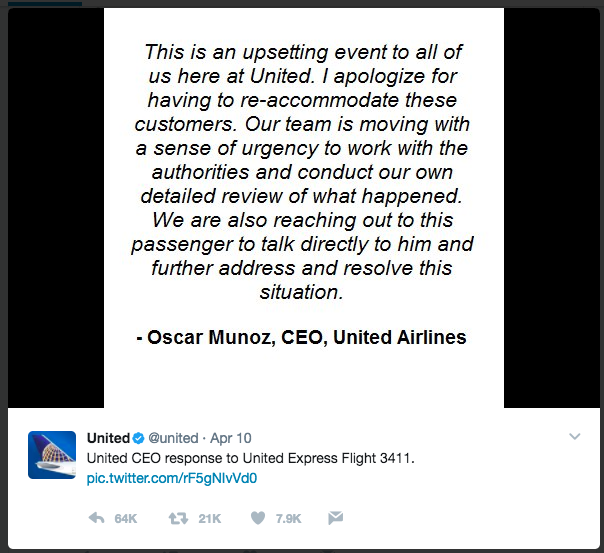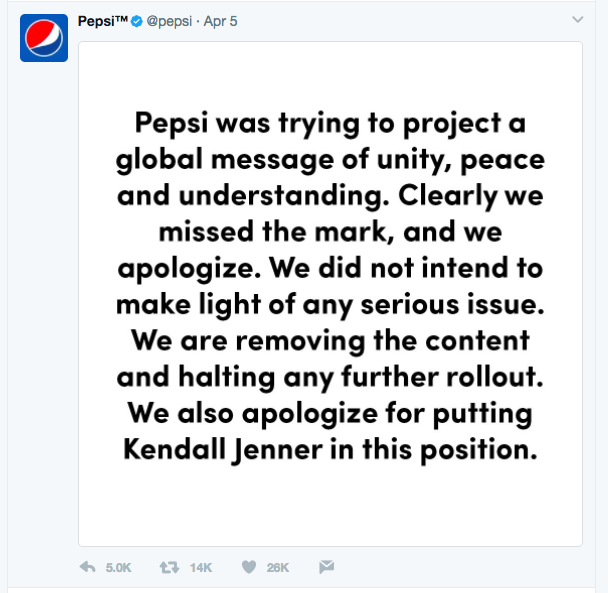The beginning of 2017 was filled with huge failures that were widely discussed on the Internet and were later identified as “the” reputation crises. First, Gitlab accidentally deleted their clients’ data from their primary database server. Later, Pepsi presented the advertising campaign that immediately failed. Then, there was the United Airlines scandal that provoked a massive outrage on social media and even a federal investigation.
Although all these issues were different, they have one thing in common — social media. Some companies did everything right and were able to deal with their crisis and even benefit from it. Others made mistakes and lost clients, money, and even their reputation. But for us, there is a bright side. We can all learn from the mistakes of others and use the techniques of successful companies for ourselves. So, let’s take a look at three crisis management case studies and see what we can learn from them.
The United Airlines PR Crisis

What happened?
The conflict occurred in United Airlines flight number 3411, which departed from Chicago to Louisville on April 9, 2017. Before passengers began boarding, it was announced that the flight was overbooked. United needed to put their employees on this plane. So, they asked for volunteers to give up their seats in exchange for $400 US, a free hotel room and a ticket for a flight the next day. No one volunteered. When boarding was complete, it was announced that four passengers had to leave the plane. Again, no one volunteered, so the company decided to choose passengers randomly. Two of the passengers left, and one refused. The one who remained said that he was a doctor and needed to get to his patients. When he refused to leave the plane, he was forcefully dragged from his seat and was struck in the process. The crisis started when a cell phone video recording of the incident was published on social media.
How did they manage the crisis?
When United realized that they couldn’t get out of the scandal, the CEO Oscar Munoz commented on the situation. He apologized for “having to re-accommodate” the customer.

This statement provoked a new wave of crisis. United’s social media audience accused him of being disrespectful and of misidentifying the cause of the problem. Instead of apologizing for forcing the passenger to deplane, Munoz apologized for his inconvenience. The company’s social media audience was indignant. They satirized the situation, created memes and GIFs, and made jokes.

What’s more, United lost more than $800 Million in revenue. United wasn’t able to manage the crisis by themselves, and they had to hire a professional crisis management team.
What can we learn from United Case?
In United’s case, the CEO apologized, but his words caused even more indignation than before. Why was that? The instance that occurred on the plane was quite traumatic to those that witnessed it personally and those that saw it on video. It deserved a heartfelt response, but the tweet showed a lack of understanding and accountability. In United’s case, the CEO’s apology sounded as if he didn’t actually care, and their audience immediately felt it.
Online apologies have to be carefully crafted. Think of the emotions that need to be addressed and consider your words carefully — “how could this be offensive”? An apology should not sound like a press-release. When a brand makes a mistake they need to own up to it and let the public know they are going to address it and ensure it never happens again.
When you are ready to apologize publicly, say it with passion and from your heart. Do not use formal language or sound like a typical press-release.
The Pepsi Advertising Fail

What happened?
Pepsi presented a brand new advertising campaign featuring the mega-celebrity Kendall Jenner. Within 48 hours the video got nearly 1.6 million views on YouTube. In the video, Kendall throws off her blond wig and runs away from a photo shoot to join a protest in the street. The most epic moment of the video is when Kendall hands a can of Pepsi to a police officer, who takes a sip and smiles at his partners.
The advertisement was immediately called “the best example of white and economic privilege” and was judged for trivializing demonstrations and serious social issues. Memes and jokes were spread all over social media. The social media crisis had begun. As in the previous case, this fiasco affected the market value of the company.
How did they manage the crisis?
Pepsi removed the video from its official social media channels and made a statement: “Pepsi was trying to project a global message of unity, peace, and understanding. Clearly, we missed the mark and we apologize.”

What can we learn from Pepsi case?
When struggling for their audience’s attention, companies love to appeal to social issues. The popular idea of creating a “buyer persona” and “speaking to the audience in their language” is a good one, but as you can see, it is possible to fail at it. “We did not intend to make light of any serious issue,” Pepsi said. Although, that was exactly what they did. The social media audience felt that the brand made light of a serious issue, and that provoked the crisis.
So, before launching a product advertising campaign — test it! Show a commercial to a small group of your target audience, and show it those outside of your targeted audience. Prevent the crisis before it starts. And when you compare Pepsi with the United case, we also see that Pepsi apologized in the right way. They summarized what happened and took responsibility. They showed that they care and were really sorry for the misunderstanding, and their social media audience appreciated that.
Before launching a product advertising campaign — test it! Show a commercial to a small group of your target audience. Prevent the crisis before it starts.
Gitlab’s Data Crisis

What happened?
On January 31, 2017, one of Gitlab’s software developers accidentally removed client's’ data from the primary database server. In addition, several backup attempts didn't work and the company lost access to a huge amount of data. Gitlab.com’s service was not available for 18 hours, which was unacceptable for the company. Just to stress the gravity of the issue, Gitlab’s clients are such companies as IBM, Sony, NASA, Alibaba, Invincea, Jülich Research Center, O’Reilly Media, Leibniz-Rechenzentrum (LRZ) and CERN, and it was their code that Gitlab accidentally deleted. The crisis started the moment Gitlab announced the issue through the social media.
How did they manage the crisis?
I can’t help but admire how Gitlab managed the crisis perfectly. How did they do it? First, Gitlab announced to their clients and their social media audience that the issue had occurred. Next, they gave a detailed explanation and told what happened and how they planned to fix it. A couple of days after the incident was solved they published the detailed explanation with the lessons they learned. You can read a detailed analysis of the situation is in the article “Six reputation management lessons you can learn from GitLab's mistake.”
And there is the interesting part comes in. Look at the social audience engagement trend. There are two spikes — the increase of reaction to the tweets. These two tweets with detailed explanation got the most engagement throw all the crisis period.

The issue was serious, and it couldn’t be fixed fast, so Gitlab did an interesting thing — they asked the professional community for help. They restored access to the data in a live format, so everyone could participate and help. Another bonus, they made communication easy:
- They made a Google Doc with live notes.
- They created the hashtag #HugOps to cover social media.
- They live-streamed on YouTube to discuss the problem-solving process.
Gitlab created a large-scale discussion and welcomed everyone to the online event. Thanks to these actions, Gitlab’s issue was no longer a crisis but a challenge for the entire professional community, and those professionals were glad to help. The issue was solved.

What can we learn from Gitlab case?
This strategy won't work for everyone, but if you know that you can not solve a problem by yourself, you could ask your social media community for help. There will always be those that will judge you, but there will also be those willing to help. The moment Gitlab asked for help, the situation was transformed from a crisis into an opportunity. The problem became important for their entire professional community. After the problem had been solved, Gitlab’s social media audience thanked them rather than judging them for the mistake. So, the lesson here is: two heads are better than one. Depending on your industry, asking for help could turn public opinion in your favor. Enlist extra help to solve the problem.
Two heads are better than one. Asking for help could turn public opinion in your favor.
Final Thoughts
Failure happens and that is okay because there is always something to learn when you fail.At some point, it will happen to all of us. What will matter the most are the actions you take after your fall.
If you monitor social media channels effectively, you'll be able to react quickly and appropriately, which is integral for any brand. There is always something to learn when you see another company have an ORM crisis. Here is what we learned from the 3 companies above:
- Understand and admit the problem. This is the essential part — understand what the real problem is before offering an apology.
- Think of the emotions that need to be addressed and consider your words carefully. When you are ready to apologize, do it right. Speak from your heart and do not make a statement that sounds like a press release.
- Communicate with your audience. Explain what happened and how you plan to fix the problem. Social media audiences love to offer advice. Some of it might be useful.
As Shayla Price (@shaylaprice) said during one of our Semrush chat, “Do not wait for a social media crisis to happen. Plan ahead.”
Passing the mic to you. Do you have any examples or advice for managing a crisis on social media?
